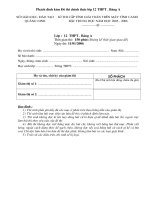CPA masses a safar nov9 05
Bạn đang xem bản rút gọn của tài liệu. Xem và tải ngay bản đầy đủ của tài liệu tại đây (5.21 MB, 48 trang )
Cerebellopontine Angle
Masses
ALI SAFAR - PGY4
November 09, 05
University of Ottawa
ENT Dept. Grand Rounds
Introduction
10% of all intracranial tumors.
Fatal without treatment.
78% are acoustic neuromas- mostly on
vestibular branch.
Other CPA masses:
Meningiomas
CN schwannomas
Dermoid tumors
Arachnoid cysts
Lipomas, metastatic tumors
Vascular tumors
Anatomy
Potential space in the posterior fossa of
the brain.
CPA boundries:
Anterior: posterior surface of temporal bone
Posterior: anterior surface of the cerebellum
Medial: lateral surface of brainstem
Lateral: petrous bone
Superior: inferior border of pons & cerebellar
peduncle
Inferior: cerebellar tonsil
Cranial nerves:
VII & VIII
V
IX, X, XI
Important structures:
Flocculus
Lateral aperture of 4th
ventrical
AICA
Differential
Acoustic Neuroma 60 - 92%
Meningioma
Epidermoids
Rare CPA lesions
Petrous Apex masses
Vascular malformations
Intra-axial masses
Acoustic Neuroma
Comprises 60-92% of CPA lesions.
Usually unilateral.
Arise from schwann cells, commonly within
IAC.
Occur with equal frequency on the Superior &
Inferior vestibular nerves.
Greatest density of S. cells at scarpa ganglion.
Majority of cases (95%) are sporadic.
Rarely occur on the cochlear division of the 8 th
CN.
Acoustic Neuroma
Type 2 NF:
Genetic defect on long arm of
chromosome 22.
Autosomal-dominant.
Bilateral or early in life.
Assoc. with intracranial meningiomas &
spinal cord tumors.
Tumors supressor gene is absent.
Pathology
Composed of Antoni A&B tissue.
Antoni A – compact tissue with spindle
cells in palisades (most common).
Antoni B – loose tissue with cyst
formation.
AN Manifestations
Cochlear:
Asymmetric SNHL
SSNHL
Up to 26% of AN may present with SSNHL
Only 1-2.5% of SSNHL is due to AN
Tinnitus
Decreased discrimination
Rollover phenomenon
Vestibular:
Dysequilibrium (more common)
Vertigo (less common)
Facial:
Facial weakness (suspect other tumors - epidermoid)
Hitselberger’s sign – decreased sensation of EAC due to
compression of CN VII sensory roots
AN Manifestations
Cerebellar:
Brainstem:
Wide gait
Falling to side of lesion
Headache
Visual Loss
Other Cranial nerves:
V – facial numbness (large tumors, trigeminal schwannoma)
VI – lateral rectus palsy (rare)
IX – dysphagia (large tumors, J F S)
X – hoarseness, aspiration (large tumors, J F S)
XI – shoulder weakness (large tumors, J F S)
Diagnostic Tests
Audiometric Testing.
Electrophysiologic Testing.
Vestibular Testing.
CT & MRI.
Audiometric Testing
Pure-tone testing:
Speech discrimination:
SNHL- most commonly high frequency (65%).
Normal hearing (5%).
Scores out of proportion with pure-tone thresholds.
Some may score well.
Rollover phenomenon improve the sensitivity.
Acoustic reflex thresholds:
typically elevated or absent.
If present then reflex decay measured.
The sensitivity is 85% for detecting retrocochlear
problem.
Electrophysiologic Testing
ABR:
Most sensitive & specific audiologic test.
Abnormalities seen:
Interaural difference in latency of wave 5
with delay of more than 0.2 msec (40-60%).
No identifiable wave forms in 20-30%.
Wave 1 present but all remaining waves are
absent in 10-20%.
Normal in 10-15%.
Vestibular Testing
ENG:
Abnormal in 70-90%.
Unilateral weakness in caloric testing.
Spontaneous nystagmus.
Only test superior nerve.
No abnormality for smaller tumors.
Computerized dynamic posturography.
Rotary chair testing.
Imaging Techniques
CT
Non-contrasted
Iodine based contrast - uptake by selected
lesions
CT air cisternogram – no longer performed
MRI
T1W – Fat density is bright
T2W – Water density is bright
FLAIR (Fluid Attenuated Inversion
Recovery)
Gadolinium
Radiologic Features of AN
CT
Non-contrast: usually isodense to brain,
calcification is rare
IV Contrast: Over 90% of non-treated tumors
enhance homogeneously
MRI
T1W – isointense to brain, hyperintense to CSF
T2W – hyperintense to brain, iso/hypo-intense
to CSF
Gadolinium – Intense enhancement of tumor
on T1W
AN Features
Centered on Porus
acousticus.
Acute angles to petrous bone
Often involves the IAC
Homogeneous enhancement
No dural tail
No calcifications
Meningioma
Second most common CPA lesion 3-7 %.
Arise from cap cells near arachnoid villi which are
more prominent near cranial nerve foramina and
venous sinuses.
Usually arise from posterior surface of the petrous
bone and usually do not extend into IAC.
Symptoms
Ataxia.
Nystagmus.
Facial hypesthesia.
Audiologic findings may show retrocochlear pattern or
may be normal.
Meningioma
Radiologic features
Tumors generally hemispherical with obtuse
angles to petrous bone
Dural tail often present (50-75%)
May herniate into middle fossa (50%)
May show calcification (25%)
Pial blood vessels with flow voids may be
present at the margins.
Treatment
Surgical removal is treatment of choice
XRT if complete excision not possible
Meningioma Features:
• Arise from surface of petrous
bone.
• Obtuse angles to petrous bone.
• Uncommonly involves the IAC.
• Frequently with dural tail.
• Calcifications common.
• Pial vessel flow voids.
Epidermoid
Accounts for 2-6% of CPA masses
Physiology:
Congenital lesions that present in adulthood
Rests of ectodermal tissue containing stratified
squamous lining and keratin
May arise within the temporal bone or in the
CPA
Benign and slow growing
Symptoms
Similar to acoustic neuroma and meningioma
Facial nerve paresis and facial twitching may occur
Epidermoid
Radiologic Features
May dumbell into middle fossa or contralateral
cistern
Highly variable in shape with a cauliflower surface
appearance
CT
MRI – homogeneous lesion
mass hypodense to CSF
Do not enhance
T1 – isointense to CSF
T2 – isointense to CSF
Differentiation from arachnoid cyst may be difficult
Diffusion weighting will show moderate intensity for
epidermoids, but low intensity for arachnoid cysts.



